Walking (and Running) in a Winter Wonderland
With several inches of snow and chilly temps, it may seem impossible to keep up with an outside walking or running routine in Wisconsin. But you can!
Use these four tips to stay active outside all winter long.
1. Get Dressed
 For a winter walk or run, clothes need to keep the muscles warm – which helps prevent injury – but not too warm that you sweat a lot and catch a chill. Plan to wear multiple layers of moisture-wicking fabric or clothes that have zippered panels to vent air when the body gets warm.
For a winter walk or run, clothes need to keep the muscles warm – which helps prevent injury – but not too warm that you sweat a lot and catch a chill. Plan to wear multiple layers of moisture-wicking fabric or clothes that have zippered panels to vent air when the body gets warm.
As you pick your cloths, also remember to wear clothing that helps you be visible to others. This means wearing reflective gear, bright, and dark materials if there is a lot of snow. By doing so, you will be more visible to drivers ultimately keeping you safer.
If slipping is a concern, add a pair of snow/ice grips to your shoes.
2. Warm Up
Warming up before a walk or run is especially important in cold weather. It loosens up muscles, gradually increases your heart rate, and preps the body for activity. In colder weather, do your warm up inside so that muscles are already warm before heading outside. Indoor warm up ideas include:
- Going up and down stairs
- Yoga
- Even vacuuming, dusting, or a quick house cleaning can warm up your body for a walk or jog
Avoid warming up so much that you are sweating before you actually leave for your walk or run.
 3. Slow Down
3. Slow Down
While you can still get out for a run or walk on most winter days, do not expect to beat personal bests for time or distance. Walkers should also take things slower to help avoid slipping.
Though it may seem safer and more appealing to run when it is warmer (10 to 40 degrees), there is more traction on snow and ice when it is colder (-5 to 25 degrees). With this being said, walkers and runners are encouraged to continue staying active, but be aware of the conditions outside and adjust your routine when needed.
There will always be days when it’s simply best to adjust your work out plans. Heavy snow, icy conditions, and sub-zero temperatures all increase your risk for injuries such as fractures, dislocations, and muscle strains. Remember: it’s better to have a couple of snow days than to be out for a week, month, or even longer due to an injury.
4. Try Something New
Snowshoeing is a great way to stay active in the winter because it was specifically designed for this time of year. Avid walkers and runners can see benefits from this activity. It not only burns a similar amount of calories as running, but it does so without the hard impact on joints. Therefore, snowshoeing is a good alternative to running for people who suffer from arthritis joint pain or those who’ve had a knee or hip replacement.
Here are two final things to keep in mind when walking and running no matter what time of year it is. First, avoiding running at dawn or dusk because these are the times with the worst visibility for drivers. Running with a buddy or making sure someone knows your planned route and estimated return time is also and important. In case of an emergency, having a buddy or someone who knows your plan could save your life.









